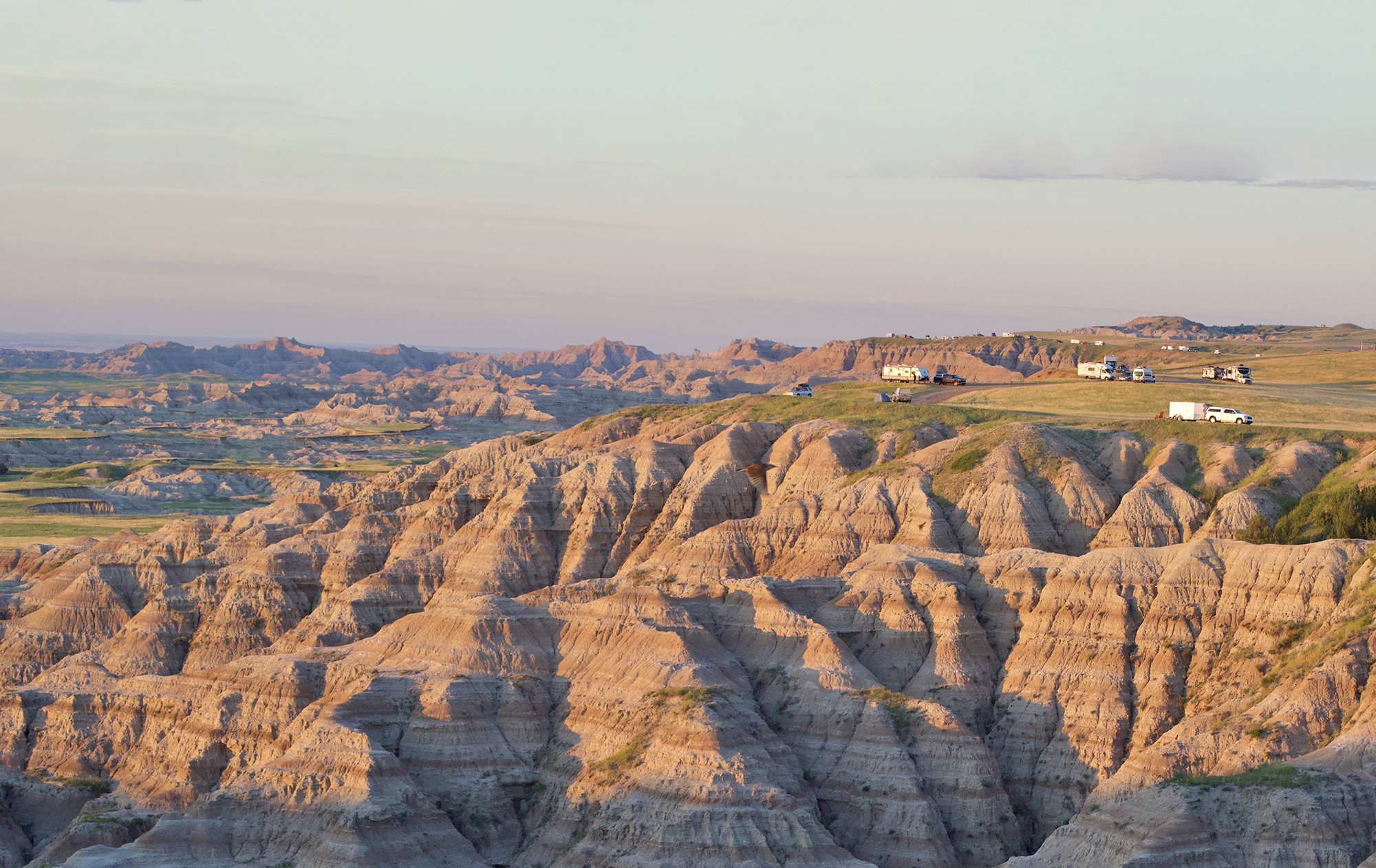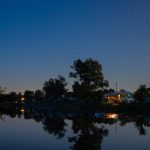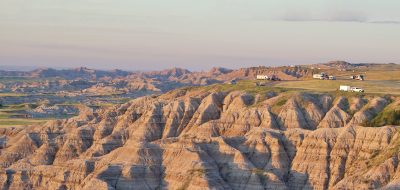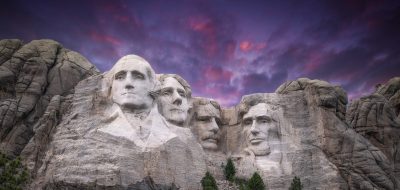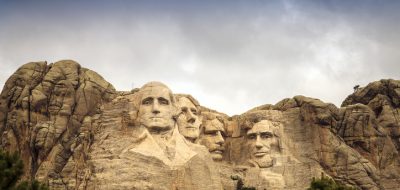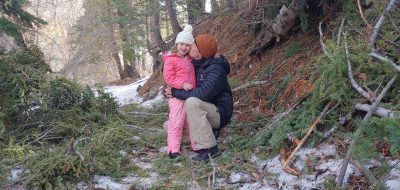Perhaps one of the most underrated states in the country, “The Land of Infinite Variety” affords visitors the chance to witness spectacular landscapes, Old West history, abundant wildlife, and Native American cultural sites. From the Black Hills and Badlands to the rolling plains and river valleys, South Dakota is the perfect spot to escape the crowds and enjoy nature’s solace.
National and State Parks

Bighorn sheep passing through camp.
Badlands National Park
Badlands National Park, located near the town of Wall, comprises over 244,000 acres of colorful spires, striped buttes and expansive grasslands. It’s renowned not only for its otherworldly beauty but also as one of the world’s richest fossil beds. Long before the arid badlands were formed, the region was part of an inland sea. Beginning in the late Cretaceous Epoch, roughly 75 million years ago, the landscape evolved when the sea receded, leaving behind clay, silt and sand. Water flowing from the Black Hills eroded this changing landscape, carving out the valleys, canyons, buttes and spires you see today. The colorful stripes within these formations not only tell the tale of time, but they also hold the answers to the first inhabitants of this area. Although no dinosaurs have been found within the park, creatures like saber tooth cats, rhinoceroses, mammoths, three-toed horses, camels and giant marine predators called mosasaurs have been found.
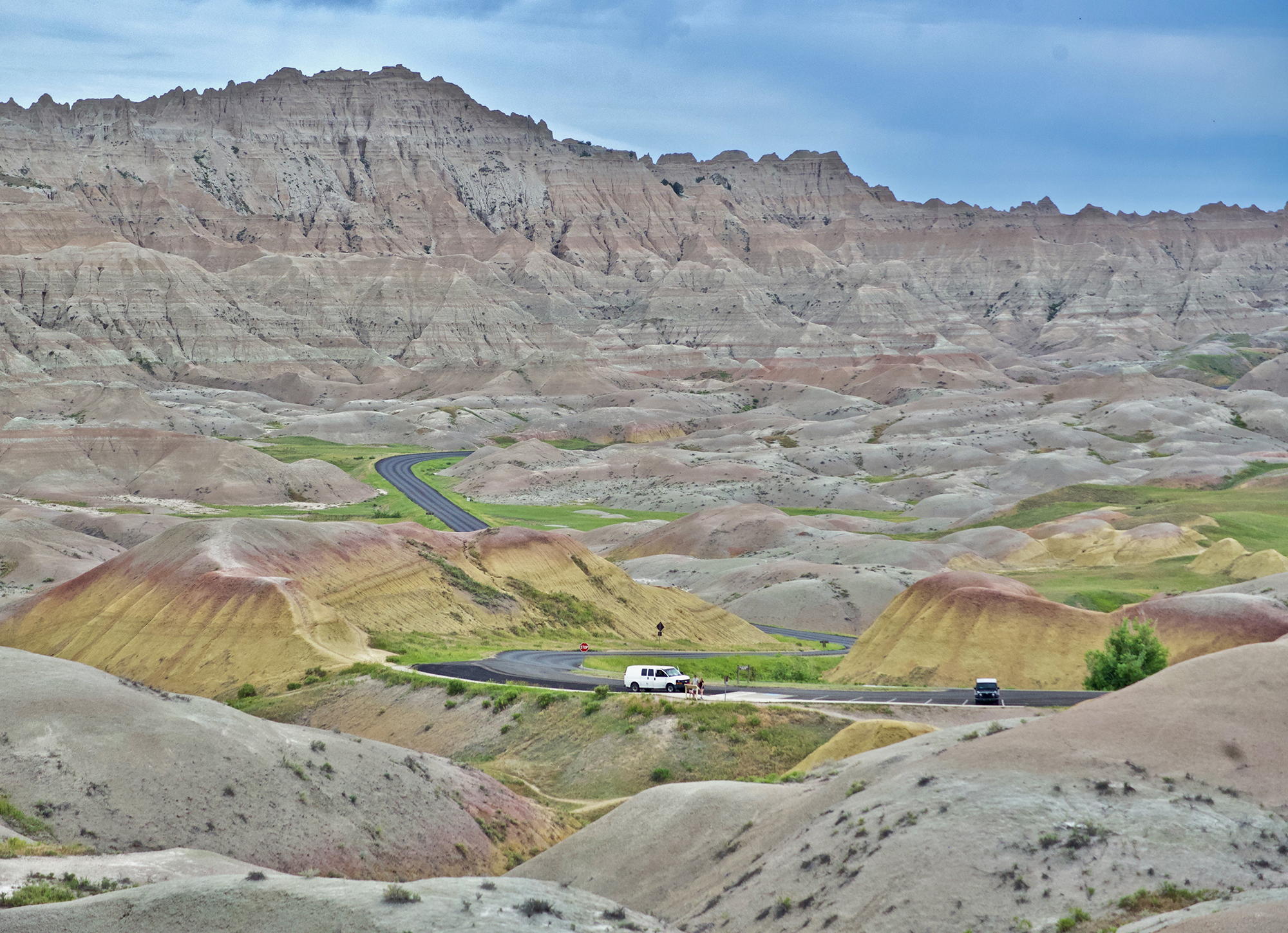
Badlands National Park viewed from Yellow Mounds Overlook.
The park is also rich in human history, as evidence of early nomadic people dating back over 10,000 years. These Paleo Indians were big game hunters, and the valleys provided the perfect hunting grounds while the top of the badlands wall served as a lookout for enemies and wandering herds. In addition to oral traditions, further evidence of these early inhabitants has been found in the arrowheads and tools they left behind from hunts and the remnants of their campfires along stream banks. If you’ve wondered how the badlands got its name, you can credit the Lakota people who dubbed the area “mako sica,” which roughly translates to badlands. Later, French trappers referred to the region as “les mauvaises terres a traverser” — bad lands to travel through, as they found the extreme temperatures, lack of water, and rough terrain hard to navigate.
While visiting the Badlands, you’ll find two distinct units: the Northern Unit, which contains most of the park’s highlights, and the less-visited Southern Unit. Within the Northern boundary, you’ll find short-but-sweet hiking trails and overlooks along Badlands Loop Road and Sage Creek Wilderness Drive. For those interested in hiking, the Notch Trail is a favorite at the park but requires a short scramble up a ladder. A good portion of the trails are under a mile and use boardwalks. But for those up for a little more adventure, “open hiking” is permitted at the park, and you can wander as you please. Just make sure to bring a map and plenty of supplies.
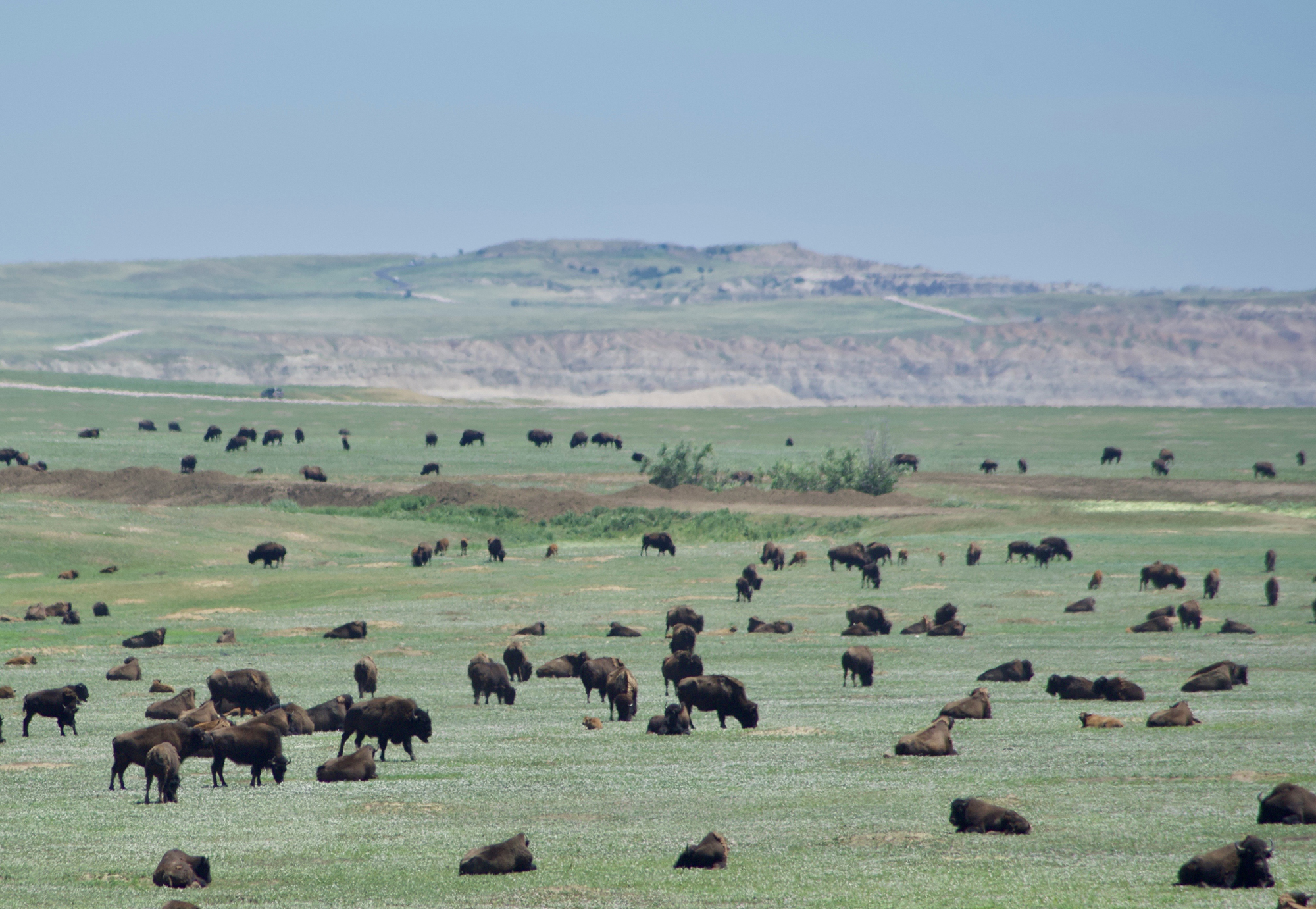
Bison along Sage Creek Wilderness Drive.
One of the best ways to enjoy the park is by taking the scenic drives that wind their way through the Badlands, affording visitors the chance to see wildlife up close. Take the Badlands Loop Road, which passes dozens of trailheads and overlooks at the park, where you’ll find the best vantage points to catch the sunrise or sunset. For wildlife viewing, the Sage Creek Wilderness Drive is quieter and often the better place to spot animals, including bison, prairie dogs and bighorn sheep.
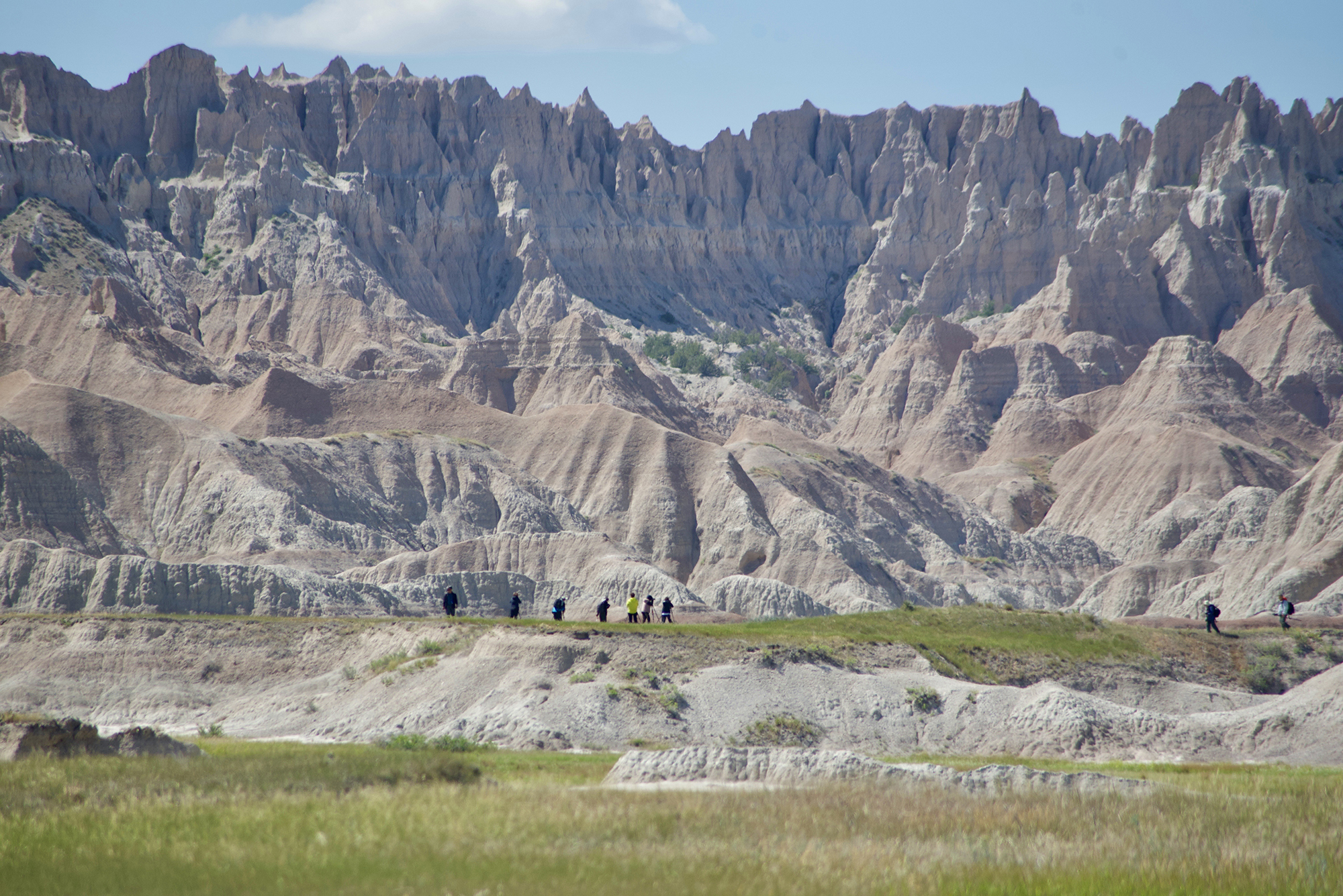
Many Badlands hiking trails are short, allowing visitors to see the park’s highlights in a brief amount of time.
Besides the National Park, there are several other points of interest in the immediate area, including the Badlands Ranch Store, Roberts Prairie Dog Town, Wall Drug and the Cold War-era Minuteman Missile National Historic Site.

Prairie dog towns are scattered throughout the park.
Wind Cave National Park
Although summers in the Badlands can be brutally hot, not far away in the Black Hills you’ll find solace at Wind Cave National Park, where the temperature remains 54 degrees year-round. Wind Cave, which is among one of the largest mapped cave systems in the world, ranks as the country’s third-largest cave and the world’s seventh-largest cave. It’s also one of the oldest national parks, established in 1903. Wind Cave is unique compared to better-known caves like Mammoth or Carlsbad because this cave contains 95 percent of the world’s discovered boxwork. Boxwork is calcite formed in thin blades that create a box-like or honeycomb pattern revealed after the bedrock and limestone have eroded.

South Dakota boasts lots of dark sky environments.
Wind Cave gets its name from the Lakota people, who called it “Maka Oniye” or “breathing earth” from the sound of the wind blowing through the small entrance. There’s plenty to see above ground, too, as the national park is home to one of the most extensive prairies in the US, where you’re sure to spot herds of bison and other wildlife.
Custer State Park and Needles Highway Scenic Drive

Taking the scenic drive along Needles Highway for sweeping views.
Located in the heart of the Black Hills, Custer State Park is a magical land of towering granite peaks, pristine mountain lakes and abundant wildlife. Encompassing over 71,000 acres, the park is a favorite locale for hiking, horseback riding, rock climbing, mountain biking and fishing. It’s also home to one of the country’s most stunning scenic drives. The Needles Highway twists and turns its way past towering rock formations and through narrow tunnels, so it’s wise to leave the trailer back at camp. At the end of one tunnel stands the Needles Eye, an impressive granite spire with a slit only 3 to 4 feet wide but reaching 30 to 40 feet in the air.

Sylvan Lake is a popular attraction during the summer months.
For your best chance to spot wildlife, take the scenic drive along Wildlife Loop Road, where you’ll likely see the area’s herd of 1,500 roaming bison. Other animals you’ll find throughout the park include pronghorns, mountain goats, mule deer, bighorn sheep, elk and begging burros. While visiting the park, stop at Sylvan Lake, known as the “crown jewel” of Custer State Park and hike the Black Elk Peak Trail, formerly known as Harney Peak, for the best panoramic view of the park. At 7,242 feet, it’s the highest point in the Black Hills.
Deadwood and the Wild West
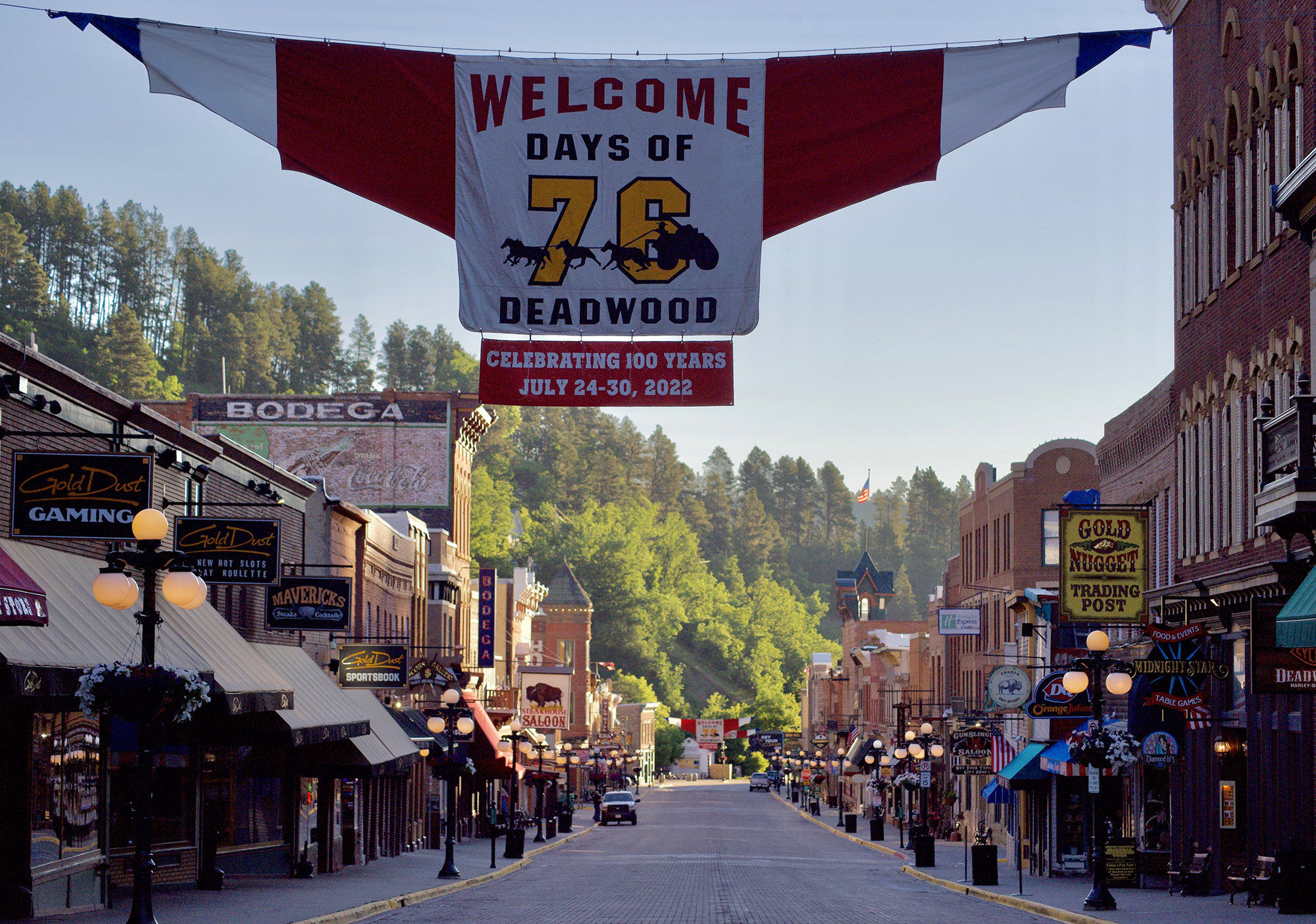
Historic Main Street in Deadwood holds regular gunfight reenactments from May-September.
Enjoy a blast from the past by heading to the historic town of Deadwood, where the discovery of gold in 1884 set off one of the largest gold rushes in history. Practically built overnight, this small mining camp boomed into a full-fledged city, boasting over 25,000 people in its heyday. This rough-and-tumble town attracted notable characters like Wild Bill Hickok, Calamity Jane, Wyatt Earp and Al Swearengen, who came for the legendary gambling and brothels. Today, you can visit many of the same places these infamous characters frequented, like the Bullock Hotel, named for the town’s first sheriff, Seth Bullock, featured in the HBO series, “Deadwood.” While visiting the Bullock Hotel and other buildings along Historic Main Street, you’ll notice a variety of architectural styles, including Queen Ann, Colonial Revival, Italianate, Art Deco, Eastlake, Second Empire and Classic Revival. Just strolling around the shops and saloons, you’ll feel like you’ve teleported to another era — especially if you’re around for one of the daily gunfight reenactments in the summer months.
For those who’d rather skip gambling, there are endless things to do in the area — especially for history lovers. Plan a visit to the Adams Museum, where you’ll find exhibits about Deadwood’s early days and artifacts like the card hand Wild Bill Hickok held when he was shot. Take a tour at Broken Boot Gold Mine, an authentic gold mine that operated from 1876 to 1904, where guests can explore Deadwood’s mining past underground. To get the best view of Deadwood and to visit the graves of many of the town’s notable gunslingers, head to Mount Moriah Cemetery, located on a hill overlooking the city.
Native American History and Culture

The Dignity Statue can be found along Interstate 90 outside of Chamberlain.
Native Americans have called the Black Hills and South Dakota plains home for over 10,000 years. These ancient nomadic ancestors of the Arikara people hunted mammoth, bison and other large game, following the herds and never staying in one place for more than a season or two. In the 18th century, the Lakota Sioux moved west from Minnesota and claimed the area. At about this time, French trappers were mapping the Missouri River, and France eventually laid claim to the region. After Thomas Jefferson made the Louisiana Purchase with Napoleon, he sent Louis and Clark to explore this new territory. With their discovery came an onslaught of Europeans moving to the Missouri River valley. Settlements and trading posts popped up, relations with Lakota Sioux soured and raids on white settlements were common. In 1886, the federal government entered a series of treaties with the tribe, including the Fort Laramie Treaty, with hopes that this sign of good faith with stave off hostilities.
The treaty established the Great Sioux Reservation, promising all land between the Missouri River and the Bighorn Mountains, as well as the Black Hills. Even though settlers were prohibited from entering the Black Hills, they continued. Eventually, Custer’s Black Hills expedition discovered gold, bringing miners to the area in droves and sparking several famous battles, including the Battle of Little Bighorn. Eventually, the Native Americans were forced out and moved onto reservations, where they continued fighting for their land rights.

The Black Hills and Badlands are considered sacred ground to the local tribes, so respecting the land is essential.
Today, there are several Native American cultural sites, museums and art installations you can visit while exploring South Dakota. One of the most critical yet somber places to visit is the Wounded Knee National Historic Site, where US cavalry soldiers massacred nearly 300 native men, women and children in 1890. Located on the Pine Ridge Indian Reservation, visitors can read the memorial panel and stop at the cemetery on the hill. Nearby in Wall, the Wounded Knee Museum tells the Native American perspective of that fateful day and the aftermath, including photographs and artifacts from the event.
To witness the only archeological site in South Dakota open to the public, head to the Mitchell Prehistoric Indian Village. Here, guests can watch as archeologists uncover artifacts of a 1,000-year-old village and the site of the area’s earliest farming communities. After viewing the activity under Archeodome — the name of the structure that protects the dig from the elements — take a tour of the Boehnen Memorial Museum, which holds over 1.5 million artifacts.
One of the state’s most beautiful statues is Dignity: of Earth and Sky, a stunning 50-foot sculpture of an indigenous woman soaring high above the Missouri River. Located along an I-90 rest stop near the town of Chamberlain, Dignity was designed by acclaimed artist Dale Lamphere to honor the cultures of the Dakota and Lakota people. She is holding a star quilt, made of 128 diamonds in the colors of sky and water that dazzle in the sunlight during the day.
The best way to see culture firsthand is to attend a powwow, a celebration of food, music, dance and art. One of the largest ones in the state is the annual Black Hills Powwow in Rapid City, which takes place every October. This celebration of Native American life and culture brings hundreds of dancers, artists and athletes from around the country and thousands of spectators. While witnessing a powwow, it’s essential to research proper etiquette, like not taking unwanted pictures or touching dancer regalia, which is considered disrespectful.

Known for its epic cloud formations, South Dakota is a popular spot for storm chasers.
South Dakota offers endless cultural and outdoor opportunities with diverse scenery, incredible history, and unparalleled wildlife.
All photos by Cate Battles.

